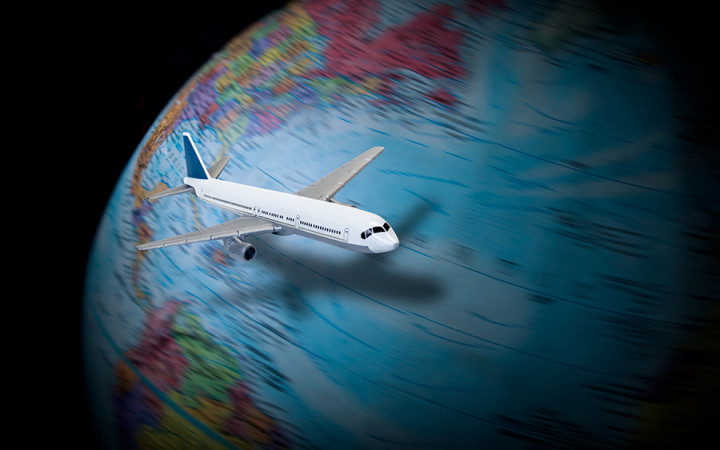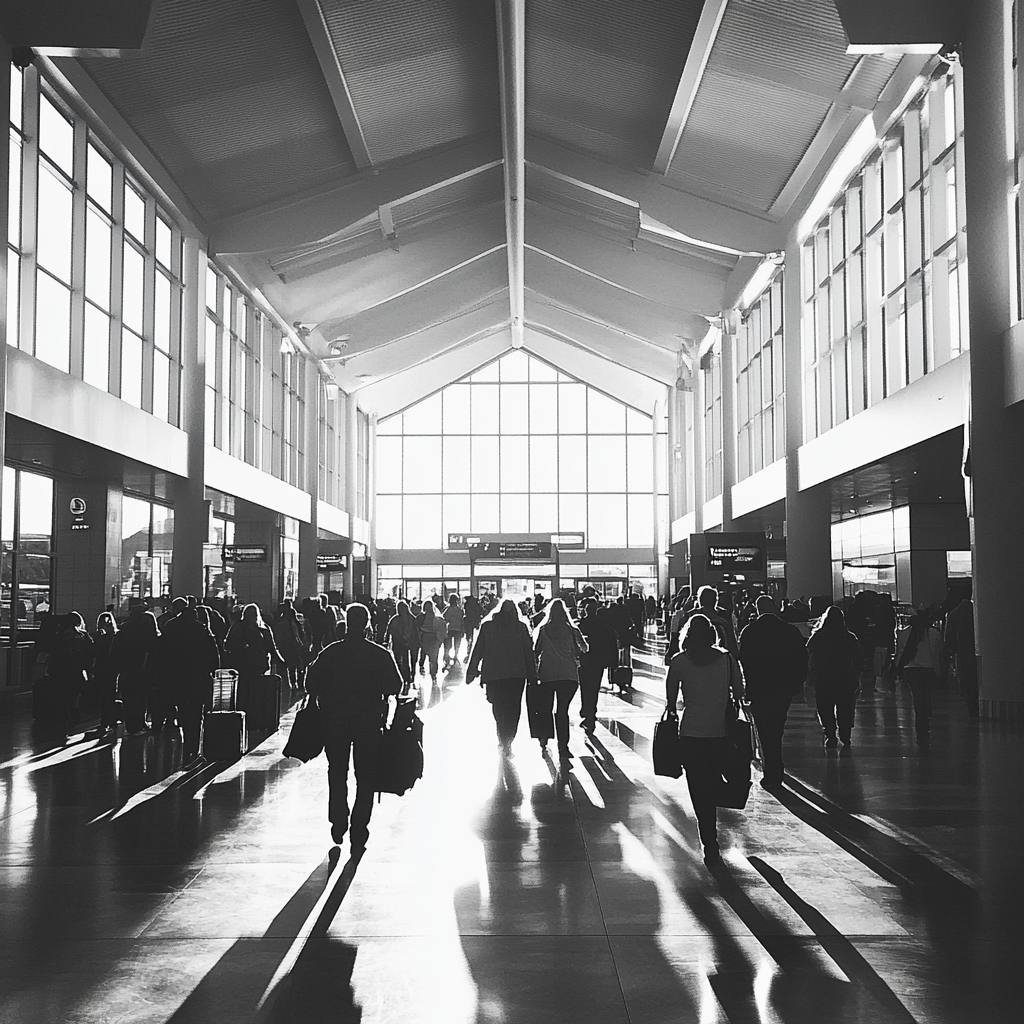Have you ever looked at a flight path on a map and wondered why airplanes take curved routes instead of flying in a straight line? Wouldn’t flying in a direct line be more fuel-efficient and faster? At first glance, it seems logical that a shorter distance would result in less fuel consumption, but in reality, aviation is far more complex.
Several factors determine flight paths, including the Earth’s shape, jet streams, weather conditions, and air traffic regulations. Let’s break down why airplanes rarely fly in a straight line and how their curved paths actually make flights more efficient.
The Earth’s Shape and the Great Circle Route

One of the biggest reasons airplanes don’t fly in a straight line is the Earth’s curvature. While we often view flight maps as flat, the Earth is a sphere, and the shortest path between two points is actually an arc called the Great Circle Route.
If you take a globe and use a string to connect two distant locations, you’ll notice that the shortest route often curves rather than follows a straight path. This is why flights from New York to Tokyo pass over the Arctic region rather than flying directly west across the Pacific Ocean.
Using the Great Circle Route helps planes save both time and fuel, even though it appears curved on a flat map.
Jet Streams and Weather Conditions Impact Flight Paths
Another key factor affecting airplane routes is jet streams—high-altitude wind currents that move at speeds of up to 200 mph (320 km/h). Pilots strategically plan routes to take advantage of these strong winds when possible.
Video : Why Airplanes Don’t Fly Straight
Flying with jet streams allows an airplane to get an extra push, helping it move faster while burning less fuel. Flying against a jet stream can slow down the plane significantly, increasing fuel consumption. Pilots often adjust routes to avoid strong headwinds, even if it means flying a longer distance.
Additionally, storms, turbulence, and severe weather conditions also play a role in determining flight paths. Airplanes may adjust mid-flight to bypass dangerous weather zones, thunderstorms, or areas with extreme turbulence.
Air Traffic Control and Flight Regulations
Air traffic isn’t a free-for-all where planes can just fly wherever they want. There are strict regulations set by aviation authorities and air traffic control (ATC) that dictate flight routes.
Some of these rules include restricted airspace, where certain areas, such as military zones, national security locations, and political zones, prohibit commercial flights from entering. Predefined flight corridors exist to avoid mid-air collisions, ensuring flights follow established air traffic lanes. Major airports handle hundreds of flights daily, so ATC ensures safe and efficient arrivals and departures.
Due to these regulations, airplanes cannot always take the most direct path and must follow designated routes instead.
Avoiding Air Turbulence for Passenger Comfort
Turbulence can make a flight uncomfortable, and pilots actively adjust routes to minimize rough air conditions. There are different types of turbulence, including thermal turbulence caused by warm air rising from the ground. Flying at higher altitudes helps avoid this.

Mechanical turbulence happens near mountains and rough terrains where wind patterns shift unpredictably. Clear-Air Turbulence (CAT) is sudden, strong air currents in high altitudes that are difficult to predict.
To ensure a smoother ride for passengers, pilots may deviate from the shortest path to avoid these turbulent areas.
Why Do Airplanes Sometimes Ascend Before Landing?
If you’ve ever been on a flight where the plane suddenly climbs just before landing, you might have felt a bit concerned. This maneuver is known as a go-around and is actually a common and safe aviation practice.
Some reasons why pilots perform a go-around include runway clearance issues. If another plane hasn’t cleared the runway in time, pilots must abort the landing and circle back. Poor weather conditions, such as poor visibility, strong crosswinds, or sudden gusts, can make a landing unsafe. If a plane is too fast, too high, or not properly aligned with the runway, the pilot will ascend and try again for a safer landing.
Go-arounds are standard procedures in aviation and ensure passenger safety above all else.
The World’s Longest Non-Stop Flight
While most flights follow curved paths, some routes push the limits of non-stop travel. The longest direct commercial flight in the world is from Singapore to Newark, New Jersey, USA.
This flight covers a distance of 10,400 miles (16,700 km) and takes approximately 18 hours and 45 minutes. It follows a carefully optimized path to balance fuel efficiency, wind conditions, and passenger comfort.
Video : Does Earth’s Rotation affect the Airplanes Speed & Flight Time
What Happens If a Plane Suddenly Loses Cabin Pressure?
A sudden drop in cabin pressure is often portrayed as a dramatic event in movies, but in reality, pilots are well-trained to handle it calmly.
When this happens, oxygen masks automatically deploy, and passengers should put them on immediately and breathe normally. The plane will descend to a safe altitude where oxygen levels are sufficient for breathing. The flight crew will assess the situation and communicate with passengers.
Losing cabin pressure doesn’t mean the plane will crash—pilots follow strict safety protocols to handle such incidents efficiently.
Final Thoughts: Why Curved Flight Paths Are More Efficient
While it may seem counterintuitive, airplanes take curved routes instead of straight lines to optimize flight efficiency, fuel usage, and passenger safety. Factors such as the Earth’s shape, jet streams, air traffic control, and weather conditions all play a crucial role in determining flight paths.
So next time you’re on a plane and see the route map displaying a curved flight path, remember there’s a lot of science and planning behind it to ensure you reach your destination as safely and efficiently as possible.
3 histórias selvagens sobre casamentos que foram totalmente destruídos no último momento

Casamentos devem ser perfeitos, com cada detalhe planejado até a última pétala no corredor. Mas às vezes, quando tudo está pronto para sair sem problemas, a vida traz algumas reviravoltas inacreditáveis.
De revelações de cair o queixo a saídas dramáticas, essas três histórias provam que nenhum casamento está realmente a salvo de desastres. Então, pegue um assento e prepare-se para um caos de casamento… porque você não vai acreditar no que aconteceu nesses “sim”!

Uma cena caótica de um casamento | Fonte: Midjourney
Eles fizeram um casamento secreto pelas minhas costas
O dia do meu casamento deveria ser lendário. Quer dizer, você pode imaginar: um celeiro enorme, 250 convidados e cada detalhe planejado até a vela final, tudo arranjado pela minha família.
Mas quando o grande dia chegou, eu estava lá, de vestido, olhando para uma sala com apenas 30 convidados.
Como se isso não fosse estranho o suficiente, logo percebi que não eram só meus primos distantes que tinham vacilado. Não. Meus pais, minhas madrinhas e até meu noivo não estavam em lugar nenhum.

Uma cerimônia de casamento montada em um celeiro | Fonte: Midjourney
Peguei meu telefone, tentando falar com qualquer um que atendesse. Primeiro, minha mãe. Depois Ethan, meu noivo. Depois madrinhas, primas e até meu tio Rob.
Silêncio mortal. Até que, finalmente, uma das minhas madrinhas atendeu.
“Onde estão todos, Celia?”, perguntei, em pânico e meio fora de mim. “O que está acontecendo? Se isso é uma brincadeira, não tem a mínima graça!”

Uma noiva falando ao telefone | Fonte: Midjourney
A voz dela era fria. Celia era prima de Ethan e quando precisei de mais uma madrinha para combinar com o número de padrinhos, ele a sugeriu.
“Perca meu número, sua mulher decadente”, ela cuspiu. “Ninguém está esperando por você aqui.”
Eu congelei.
“O que você quer dizer? Celia! Em que… cerimônia você está? Estou sozinha na entrada do celeiro!”
Houve uma pausa, o ar ficou mais denso.

Uma madrinha falando ao telefone | Fonte: Midjourney
“Ah, então você não sabe?” ela riu secamente. “Aqui, vou passar para sua mãe. Ela vai explicar para você.”
Pude ouvir um farfalhar do outro lado da linha, e então a voz da minha mãe surgiu, casual, como se ela estivesse me ligando para falar sobre planos de brunch semanal.
“Você não recebeu minha mensagem esta manhã?” ela perguntou.

Uma mulher mais velha falando ao telefone | Fonte: Midjourney
“Que mensagem? Mãe, do que você está falando? Por que vocês estão fazendo isso comigo?”, perguntei, as lágrimas quase caindo pelo meu rosto.
Minha mãe suspirou como se eu fosse a causadora dos problemas.
“Bem”, ela começou, e eu praticamente podia ouvir a presunção em sua voz. “Olha, Amy. Nós apenas pensamos que Ethan ficaria melhor com sua prima. E bem, ela está grávida.”

Uma noiva chateada | Fonte: Midjourney
Suas palavras me atingiram como um golpe baixo em uma briga.
“O quê? Qual primo? Do que você está falando?”
“Ashley, Amy”, minha mãe disse. “Ela está esperando o bebê de Ethan. E todos nós achamos que eles seriam um casal melhor do que você e ele, de qualquer forma. Então marcamos uma cerimônia esta manhã. Eles são um casal agora. Um casal esperando seu bebê juntos.”

Uma noiva grávida | Fonte: Midjourney
Fiquei ali, segurando meu telefone com tanta força que meus dedos ficaram brancos.
“Então, o casamento em que estou…” eu disse lentamente, sentindo as palavras cortarem minha garganta. “É só um disfarce? Ou uma brincadeira? Você gostou de me machucar?”
“Querida, você é jovem. Você vai superar isso”, minha mãe respondeu, seu tom indiferente. “Família tem que tomar decisões difíceis às vezes. Apenas… volte lá e encerre as coisas. Talvez você receba um reembolso pela comida.”

Uma mulher falando ao telefone | Fonte: Midjourney
Deixei meu telefone cair, minha cabeça girando. Isso não podia ser real. Olhei em volta para os convidados que tinham aparecido, pessoas que não tinham me abandonado por alguma trama distorcida e aprovada pela família.
Respirei fundo, pisquei para conter as lágrimas e fiz a única coisa que consegui pensar.
Chegando à frente do celeiro, levantei a voz.

Uma noiva chateada | Fonte: Midjourney
“Olá a todos”, comecei, forçando um sorriso. “Obrigada por terem vindo. Sei que vocês estão se perguntando onde todos os outros estão. Bem… eu também.”
Algumas risadas confusas percorreram a sala, e eu respirei fundo. Percebi que os convidados presentes eram principalmente meus colegas de trabalho e os de Ethan. Claro, eles não tinham sido informados da mudança de planos.
“A verdade é que minha família não está aqui porque decidiram que não era eu quem deveria se casar hoje.”

Convidados em um casamento | Fonte: Midjourney
Eu suspirei.
“Aparentemente, eles fizeram um casamento para meu noivo e meu primo esta manhã. Eles são um casal esperando seu bebê juntos”, eu disse, ecoando as palavras da minha mãe.
Suspiros e murmúrios preencheram o espaço. Uma amiga na primeira fila cobriu a boca, os olhos arregalados.

Uma mulher chocada em um casamento | Fonte: Midjourney
“Obrigado por estarem aqui”, eu disse, olhando ao redor dos rostos chocados. “Eu não sei como entender isso ainda, mas sou muito grato a cada um de vocês.”
Acenei para todos, virei-me e saí do celeiro.
Já se passaram anos desde aquele dia. Mudei-me para longe, cortei todos os laços e comecei de novo. Às vezes, as pessoas perguntam por que não falo com minha família, mas eu apenas sorrio e digo que eles estão melhores sem mim.
Eles podem todos ir para o inferno.

Uma mulher sentada em seu apartamento | Fonte: Midjourney
Minha cunhada decidiu arruinar meu casamento porque não sou boa o suficiente para o irmão dela
Eu tinha ouvido falar muito sobre a irmã de Colin, Meredith. Ele a descreveu como uma pessoa de temperamento forte e divertida, alguém com quem ele compartilhava uma conexão profunda.
Então, quando ela finalmente voou para o nosso casamento, fiquei animado para conhecê-la. Eu esperava um começo caloroso, mas nada me preparou para o que aconteceu.

Um casal sorridente | Fonte: Midjourney
Quando cheguei em casa, pude ouvir risadas vindas da sala de estar. Quando entrei, encontrei Colin e Meredith no sofá, rindo enquanto ele fazia cócegas nela. Parecia brincadeira, mas algo parecia estranho.
Não me entenda mal, esta não é uma história sobre relações familiares inapropriadas ou algo do tipo. Meredith e Colin eram apenas muito próximos.
“Ei”, eu gritei.

Irmãos sentados em um sofá | Fonte: Midjourney
Mas não houve resposta. Tentei novamente, mais alto dessa vez.
“Ei!”
Ainda sem resposta.
Finalmente, farto, levantei minha voz para a minha melhor voz de professor de jardim de infância.
“Colin!”

Uma mulher parada na porta | Fonte: Midjourney
Eles pararam de rir, e Meredith me lançou um olhar sujo.
“Nossa, não precisa gritar”, ela disse.
Colin deu um pulo, parecendo surpreso.
“Alexis! Querida, não ouvi você entrar”, ele disse. Ele me abraçou, mas eu mal conseguia responder.

Uma mulher carrancuda | Fonte: Midjourney
“Vocês dois pareciam muito ocupados”, eu disse, forçando um sorriso.
Meredith riu.
“Ele sempre foi assim comigo”, ela disse. “Fazer cócegas sempre foi uma coisa de família. Nós simplesmente amamos ouvir um ao outro rir.”
Tentando ignorar a vibração estranha, estendi a mão para abraçá-la.

Duas mulheres se abraçando desajeitadamente | Fonte: Midjouney
“Meredith, estou tão feliz de finalmente conhecer você!” eu disse.
Ela me abraçou de volta, mas friamente, como se me tocar fosse um tabu.
“Bem, Colin não me contou muito sobre você”, ela disse.
“Colin não?” Colin repetiu, franzindo a testa. “Isso não é verdade, Mer. Eu já te contei bastante sobre Alexis.”

Um homem sorridente | Fonte: Midjourney
Ela deu de ombros.
“Por que você não foi ao aeroporto com ele?”, ela perguntou, com um tom áspero e repreensivo.
“Eu estava no trabalho; não podia sair”, expliquei, sentindo-me desconfortável naquele momento.
Meredith levantou uma sobrancelha.
“Bem, eu teria tirado o dia de folga se minha futura cunhada estivesse me visitando e eu a estivesse conhecendo pela primeira vez.”

Um aeroporto movimentado | Fonte: Midjourney
“Se eu pudesse, eu teria feito”, respondi, mantendo a voz firme.
Durante o jantar, tentei participar, mas Meredith continuou direcionando a conversa para memórias que só eles compartilhavam. Toda vez que eu falava, eles simplesmente seguiam em frente como se eu não tivesse dito nada.
Em vez de tentar mais, torci meu anel de noivado no meu dedo. Mentalmente repassei os planos do casamento, lembrando a mim mesma que precisava decidir sobre os arranjos florais finais. E o design final do bolo de casamento.

Um anel de noivado na mão de uma mulher | Fonte: Midjourney
Eu também precisava escolher a música que eu queria que caminhasse até o altar. De repente, a lista parecia muito longa e cansativa…
Depois do jantar, Colin se levantou para ajudar a limpar a mesa.
“Nossa, sua futura esposa não consegue nem lavar a louça sozinha?”, Meredith murmurou, olhando para mim.
“Mer, não me importo de ajudar”, ele respondeu, dando de ombros.
Ela apenas sorriu.

Pratos sujos na mesa | Fonte: Midjourney
“Bem, eu não sei como as coisas andam por aqui, mas eu não deixaria meu noivo fazer ‘trabalho de mulher’ assim. Mas é sua vida, Colin.”
Ela se virou, deixando seu prato para Colin pegar de qualquer maneira.
“E não demore, Colin”, ela disse. “Estarei esperando por nossa maratona de filmes. Você e eu, como nos velhos tempos.”
Senti minha paciência se esgotar pela metade.

Um casal conversando na cozinha | Fonte: Midjourney
“O que foi tudo isso?”, perguntei a Colin quando ela já tinha ido embora, provavelmente já se acomodando no quarto dele.
“Oh”, ele disse, segurando uma panela suja. “Esqueci de te contar, Mer vai fazer uma maratona de filmes comigo hoje à noite. E eu queria fazer isso no meu quarto porque minhas costas e o sofá não são amigos.”
“E onde eu vou dormir?”, perguntei.
“Você pode dormir no quarto de hóspedes”, ele respondeu calmamente.

Um casal conversando na cozinha | Fonte: Midjourney
“Por que ela não dorme no quarto de hóspedes?” perguntei.
“Vamos, Alexis”, ele suspirou. “Não tem TV no quarto de hóspedes. E é só uma noite, querida.”
“Tudo bem, mas só por esta noite.”
Na manhã seguinte, depois de uma noite sem dormir, fiz panquecas, as preferidas de Colin. Meredith entrou, me observando com um sorriso irônico.

Uma mulher fazendo panquecas | Fonte: Midjourney
“O que você está fazendo?” ela perguntou.
“Panquecas de chocolate. As preferidas do Colin”, respondi secamente.
Ela zombou alto enquanto colocava a chaleira no fogo.
“Colin gosta de panquecas com bacon, Alexis”, ela disse como se eu fosse idiota. “Eu conheço meu irmão.”

Uma chaleira em um balcão | Fonte: Midjourney
“Talvez quando vocês eram crianças”, eu disse. “Mas agora ele gosta de gotas de chocolate.”
“Colin!”, ela gritou de repente. “Que tipo de panqueca você gosta mais? De gotas de chocolate ou de leitelho puro com bacon ao lado?”
“Bacon, eu acho”, ele respondeu rapidamente.
Senti meu coração apertar.
“Mas eu faço panquecas de chocolate para você o tempo todo”, eu disse.

Uma mulher chateada | Fonte: Midjourney
“Sim, mas querida, elas não são iguais às da Meredith.”
“Eu te disse”, ela disse, com satisfação transparecendo em sua voz.
Coloquei a espátula de lado.
“Tudo bem, deixe Meredith fazer seu café da manhã”, eu disse.

Um prato de panquecas com bacon | Fonte: Midjourney
Mais tarde, ouvi a conversa deles.
“Seu noivo não é bom o suficiente para você, Colin. Você merece algo melhor, e sabe disso.”
“Você está certo”, respondeu Colin. “Eu vou falar com ela.”
Furioso, entrei na sala de estar.

Uma mulher carrancuda | Fonte: Midjourney
“Já estou farto dessa bobagem”, eu disse. “Se você está escolhendo ficar do lado dela em vez de mim, então pode ficar com ela, Colin.”
Joguei meu anel de noivado nele e ouvi-o quicar no chão.
Virei-me, minha mente estava tomada. Eu estava pronta. E assim, meus sonhos de casamento acabaram antes mesmo de realmente começarem.

Um anel de noivado em um tapete | Fonte: Midjourney
Homem descobre traição de sua noiva – Ele vai ao altar com um controle remoto nas mãos
Conforme o casamento do meu irmão Liam se aproximava, a excitação zumbia no ar. Liam, famoso por suas pegadinhas, insinuou uma grande surpresa para o grande dia, deixando todos nós nervosos.
Ele e Denise estavam juntos há anos, e quando ela me pediu para ser madrinha, pareceu a escolha certa.
Denise era como uma família.
“Daphne, preciso de você comigo no meu grande dia”, ela disse, me presenteando com uma caixa de guloseimas. “Você não é só irmã do Liam, você é minha também.”

Duas caixas embrulhadas para presente | Fonte: Unsplash
Eu aceitei de bom grado.
Denise tinha até planejado meu aniversário de 21 anos quando meus amigos não compareceram, então pensei que a conhecia bem. E para ser honesto, ela passou mais tempo planejando seu casamento comigo do que com Liam, que parecia contente em simplesmente aparecer no dia.
Mas secretamente, ele estava montando uma montagem de vídeo surpresa para exibir antes dos votos.

Balões de foil dourados do 21º aniversário | Fonte: Unsplash
“Estou salvando todas as nossas melhores fotos e vídeos”, ele me disse uma noite, me mostrando o projeto em seu laptop. Eu podia ver o esforço que ele estava colocando nele, e isso derreteu meu coração.
Na manhã do casamento, fui ver Liam.
“Você não tem ideia do que está por vir”, ele brincou, tomando champanhe enquanto se preparava.

Um homem usando um laptop | Fonte: Unsplash
“Nossa”, eu ri, sentindo o suspense. “Mal posso esperar.”
A cerimônia foi perfeita. Denise havia planejado cada detalhe, das flores à música. Mas quando chegou a hora dos votos, Liam levantou a mão.
“Espere”, ele disse ao padre. “Tenho algo para mostrar a todos vocês.”
Ele pegou um controle remoto e seus padrinhos empurraram uma grande TV para a frente do altar.

Um casal ajoelhado diante de um padre | Fonte: Unsplash
“Esta”, ele anunciou, “esta… é a nossa história de amor.”
A tela se iluminou com imagens da vida de Liam e Denise juntos — seus primeiros encontros, férias, noites passadas cozinhando juntos. Os convidados ficaram encantados, e o rosto de Denise brilhou enquanto ela assistia.
Mas então o vídeo mudou.

Uma pessoa segurando um controle remoto | Fonte: Unsplash
Em uma curva fechada, um novo clipe foi reproduzido.
Denise estava na casa deles, mas não estava sozinha. Ela estava com outro homem, envolta em seus braços, em lingerie.
A sala ficou mortalmente silenciosa. As cabeças dos convidados se voltaram para Denise, cujo rosto havia se tornado fantasmagoricamente pálido. Sua boca se abriu, mas nenhuma palavra saiu.

Uma foto íntima de um casal | Fonte: Pexels
“Isso… não pode estar acontecendo”, ela gaguejou, mais para si mesma do que para qualquer outra pessoa.
Então, para choque de todos, o homem do vídeo, um convidado sentado no fundo, levantou-se visivelmente abalado.
“Ah, droga”, ele murmurou, olhando ao redor nervosamente.
A voz de Liam quebrou o silêncio.

Um homem de terno | Fonte: Pexels
“É por isso que não vou me casar com Denise hoje”, ele disse, sua voz calma, mas carregada de raiva. “Eu não podia deixar todo mundo aqui testemunhar uma mentira.”
A atmosfera mudou de comemorativa para tensa. Denise cambaleou para trás, olhando ao redor como se estivesse procurando um aliado.
Ela tirou os saltos, segurando-os pelas tiras.

Uma noiva segurando seus sapatos | Fonte: Pexels
“Liam, por favor, aqui não”, ela implorou, com a voz embargada. “Vamos conversar lá fora.”
Meu coração se contorceu enquanto eu a observava. Denise e eu éramos tão próximas, mas agora eu a via como ela era: alguém que machucou meu irmão.
As lágrimas dela não o comoveram.
“Há quanto tempo isso vem acontecendo?” Liam perguntou.

Uma noiva chorando | Fonte: Pexels
“Não muito tempo”, ela sussurrou, sua compostura desmoronando. “Eu nunca quis que você descobrisse.”
“Na nossa casa, Denise?”, ele perguntou, sua voz dura. “Você o trouxe para nossa casa.”
Os convidados ficaram boquiabertos, alguns sussurrando, outros se afastando da cena que se desenrolava.
O padre, sem saber o que fazer, deu um passo para trás. Denise deu um passo trêmulo em direção a Liam, com lágrimas escorrendo pelo rosto.

Um casal deitado na cama | Fonte: Pexels
“Liam, por favor. Vamos conversar sobre isso.”
Mas ele se virou e andou pelo corredor, deixando-a ali sozinha. Denise correu atrás dele, chamando seu nome, mas ele nem olhou para trás.
Mais tarde, encontrei Liam no bar do hotel, comendo uma tigela de azeitonas e tomando uma bebida. Ele olhou para cima quando me aproximei.

Uma noiva correndo | Fonte: Unsplash
“Você sabia?” ele perguntou calmamente.
“Não”, eu disse. “Eu não tinha ideia.”
Ele tomou um longo gole e então suspirou.
“Encontrei o vídeo enquanto olhava os arquivos de Denise. Pensei que encontraria mais fotos para adicionar à montagem, mas em vez disso… encontrei isso.”

Um coquetel em uma bandeja | Fonte: Unsplash
“Fui longe demais, mostrando para todo mundo?”, ele perguntou.
Pensei por um momento. Não havia boas respostas aqui.
“Talvez”, admiti. “Mas ela não lhe deixou escolha. Você merecia a verdade.”
Liam deu um pequeno aceno de cabeça.
“Vamos encontrar um pouco de bolo”, ele disse finalmente. “Não deve ser desperdiçado.”
Segui meu irmão até a sala de jantar, deixando Denise ser o passado. Agora mesmo, ele precisava de mim no seu canto.

Um bolo de casamento branco com frutas | Fonte: Unsplash
Casamentos são feitos para celebrar o amor, mas às vezes eles revelam verdades chocantes. Essas histórias nos lembram que nenhuma cerimônia ou relacionamento está a salvo de surpresas.
E alguns finais são melhores deixados no altar.
Se você gostou desta compilação, aqui vai outra para você |
3 histórias de herança incríveis com reviravoltas inesperadas
Quando entes queridos morrem, eles geralmente deixam para trás mais do que posses. Nessas três histórias, heranças inesperadas revelaram segredos surpreendentes, verdades dolorosas e lições transformadoras, provando que o verdadeiro legado nem sempre é material.
Essas histórias de herança notáveis revelam reviravoltas que trouxeram as maiores lições da vida. Elas provaram que os presentes mais valiosos não podem ser medidos em dinheiro.

Um homem mais velho sorrindo | Fonte: Midjourney
Leia o artigo completo aqui .
Este trabalho é inspirado em eventos e pessoas reais, mas foi ficcionalizado para fins criativos. Nomes, personagens e detalhes foram alterados para proteger a privacidade e melhorar a narrativa. Qualquer semelhança com pessoas reais, vivas ou mortas, ou eventos reais é mera coincidência e não intencional do autor.
O autor e a editora não fazem nenhuma reivindicação quanto à precisão dos eventos ou à representação dos personagens e não são responsáveis por nenhuma interpretação errônea. Esta história é fornecida “como está”, e quaisquer opiniões expressas são as dos personagens e não refletem as opiniões do autor ou da editora.



Leave a Reply